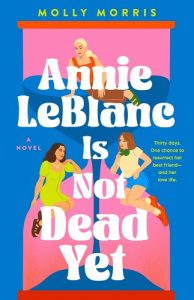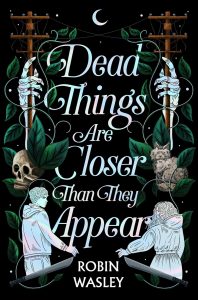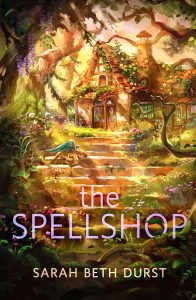The Year in Review 2024 by Colleen Mondor

As we are given carte blanche to write about books however we wish in these annual essays, I am going to indulge myself and share some thoughts on the titles I read in the past year that particularly impressed and/or made me happy. There were several surprises, including Annie LeBlanc Is Not Dead Yet by Molly Morris. This coming-of-age drama veers from the expected as soon as the reader realizes it is about a teen trying to make amends with a friend by winning their hometown’s unique lottery program which allows a resident to come back  to life if a compelling case can be made for their return. (So yes, Annie LeBlanc is dead despite the title.) There was nothing zombie-related, however, in this story about how quickly relationships can go sideways, small hurts can be magnified, and guilt can consume someone when they don’t have time to make things right. How a community ends up with the ability to bring someone back from the dead is a mystery that ends up well worth pursuing, and adds to this singular title that was like nothing else I read in 2024.
to life if a compelling case can be made for their return. (So yes, Annie LeBlanc is dead despite the title.) There was nothing zombie-related, however, in this story about how quickly relationships can go sideways, small hurts can be magnified, and guilt can consume someone when they don’t have time to make things right. How a community ends up with the ability to bring someone back from the dead is a mystery that ends up well worth pursuing, and adds to this singular title that was like nothing else I read in 2024.
Liselle Sambury’s Tender Beasts was a teen horror title that scared the bejeezus out of me in the midst of raising questions about family secrets, shifting alliances, and who you can trust in a world where mom and dad are playing a long game of terrifying proportions. (Philip Larkin was so right about how parents can fuck you up. Go read his poem ‘‘This Be the Verse’’ and see how it applies to Sambury’s novel.) Aimee Pokwatka’s The Parliament was a different sort of scary as the denizens of a local library find themselves trapped by a suddenly homicidal flock of owls, to which the local authorities are woefully incapable of handling. (The best part is the folks who insist there is nothing to fear from some small owls and walk defiantly out the doors and…. well, has nobody seen The Birds anymore? Am I the only one who has that scene with Tippi Hedren in the phone booth burned into my brain?)
 Dead Things Are Closer Than They Appear reminded me of Attack the Block and Red Dawn, albeit with a magical portal and zombies. A group of teenagers rises up against a billionaire, determined to harness the magic from their community for his own diabolical ends, who finds a lot more fight among the local population than he expected. While I am always delighted with a story that involves arrogant jerks getting their proper comeuppance, author Robin Wasley packs this novel with great characters, plenty of tension, and all sorts of mystery. Also, spoiler alert, the good guys win. I can’t recommend this one enough.
Dead Things Are Closer Than They Appear reminded me of Attack the Block and Red Dawn, albeit with a magical portal and zombies. A group of teenagers rises up against a billionaire, determined to harness the magic from their community for his own diabolical ends, who finds a lot more fight among the local population than he expected. While I am always delighted with a story that involves arrogant jerks getting their proper comeuppance, author Robin Wasley packs this novel with great characters, plenty of tension, and all sorts of mystery. Also, spoiler alert, the good guys win. I can’t recommend this one enough.
Other Young Adult novels that stood out include The Lies We Conjure by Sarah Henning, a snarky and occasionally intense title that follows two sisters over a dangerous weekend after they agree to pretend to be the granddaughters of a woman they barely know. In exchange for a few thousand dollars, they just have to embrace their inner thespians and act like they belong. Billed as ‘‘Knives Out with witches,’’ this one was splendid fun to read. For those who like their fantasy with more of a classic twist, Sleep Like Death is another reimagined fairy tale by Kalynn Bayron. This time she invigorates Snow White with a ferocity and power that was previously lacking, while also deepening the story and introducing elements of other tales as well. (I would tell you more, but the spoilers would be massive.) Bayron continues to be one of the best in teen fantasy and a must-read for fans of the genre.
The quietest book I read last year was Kelly Murashige’s The Lost Souls of Benzaiten. Protagonist Machi has shrunk her life down to online classes from home and visits with a rotating group of therapists after her former best friends destroyed her in an all too familiar example of teenage meanness. Following an unexpected encounter with the Japanese goddess Benzaiten, she finds herself in a new friendship that slowly opens her back up to the world. Wry and poignant, I was delighted with this novel, which is certain to be a balm to the souls of any teen who has suffered a similar hurt. Murashige has a new book due in 2025, The Yomigaeri Tunnel, and I’m very much looking forward to reading it.
I also read many titles for adults last year, several of them in the newly popular romantasy genre. Constance Fay successfully followed up her sexy space opera Calamity with more interstellar love and adventure in Fiasco. Meanwhile, Beth Revis had two entries in her ongoing trilogy of space heists with Full Speed at Crash Landing and How to Steal a Galaxy. They explored a ‘‘will they or won’t they’’ romance for protagonists Ada Lamarr and Rian White, while also including plenty of subterfuge. Both authors excel at worldbuilding while keeping the action and romance on center stage. Look for 2025 titles from each of them.
India Holton set her novel The Ornithologist’s Field Guide to Love in the Victorian era and draws on the classic trope of smart women battling for respect while exchanging witty repartee with male counterparts. This time the central duo is competing in a birdwatching competition set in an alternate history where magic is ever present, which means some terrifically dangerous encounters with powerful birds. Whimsical and charming doesn’t being to describe Holton’s dialogue, and Field Guide has plenty of crossover appeal to teen readers. A sequel is due in 2025, The Geographer’s Map to Romance.
 Author Sarah Beth Durst has created a world in the midst of a civil war over the teaching (and learning) of magic that results in a librarian and her sentient spider plant (yes, a spider plant), having to flee for their lives. The Spellshop is capital ‘‘C’’ cozy and has all the requisite cottages, gardens, and baked goods. But there is also a strong message about the value of education and how political leaders control access to it in order to weaken the larger population. Yes, there is a romance, but it blends into a big story about why libraries need to be open to all and how to make friends, and why you should use the magic you have to change the world. Durst already has many teen fans; The Spellshop, and its upcoming companion novel, The Enchanted Greenhouse, will only widen that appeal.
Author Sarah Beth Durst has created a world in the midst of a civil war over the teaching (and learning) of magic that results in a librarian and her sentient spider plant (yes, a spider plant), having to flee for their lives. The Spellshop is capital ‘‘C’’ cozy and has all the requisite cottages, gardens, and baked goods. But there is also a strong message about the value of education and how political leaders control access to it in order to weaken the larger population. Yes, there is a romance, but it blends into a big story about why libraries need to be open to all and how to make friends, and why you should use the magic you have to change the world. Durst already has many teen fans; The Spellshop, and its upcoming companion novel, The Enchanted Greenhouse, will only widen that appeal.
For those who enjoy a more familiar setting, Gwenda Bond plunks a complicated art heist into contemporary Kentucky and brings A LOT of family drama onto the page. Everyone is magical, but magic has done little to help this group of thieves get along. Pulling off the score is one part of the thorny problem protagonist Dani Poissant must contend with: There is also her mother, the big thing she did that blew up her relationship with her mother, the relationship her mother has with a powerful man who is now interceding in their contentious relationship, and a guy… who is a whole other but much more appealing problem. The Frame-Up is sweet fun for teen and adult readers.
Switching gears, both Katherine Arden and H.G. Parry set their novels in the World War I era with striking levels of success. In The Warm Hands of Ghosts, Arden draws from the 1917 Halifax, Nova Scotia harbor explosion to start the story of a Canadian nurse who returns to the front lines in search of her brother while Parry considers the devastating impact of a powerful faerie’s appearance on an infamous battlefield in The Scholar and the Last Faerie Door. Both authors do outstanding jobs of infusing the horrors of that particular war with magic while building on the period’s history of post-traumatic stress disorder (then called ‘‘shell shock’’) that Pat Barker wrote about so effectively in her Regeneration Trilogy (historical fiction titles I also recommend). Other than the war’s impact on setting, the books could not be more different, with Ghosts taking place on the battlefield and Faerie Door occurring a few years later as the war resonates among survivors. I found the research done by these authors to be most impressive and their novels, more than once, gut-wrenching.
Even now, months after reading, I can’t get Jennifer Thorne’s Diavola out of my head. It’s such delicious dark fantasy that also manages to be an outstanding study of classic family dysfunction. Imagine yourself, an adult, in a vacation rental along with your parents, siblings, their partners, and their children – and when you all begin to suspect the place is haunted, there is an actual disagreement about fleeing for your lives because mom and dad will lose their deposit, your sister’s meticulous plans will be upset, and your brother is too much of a ninny to make a decision that will get him in trouble. It all goes sideways, things get much worse, and survival becomes questionable while people squabble about packing up their precious suitcases and arguing over who to blame. By the final pages, for all its horrors, Diavola was much more of a realistic family story than Thorne might have planned. Or maybe she knew what she was doing all along, and none of us should ever go on such potentially fraught vacations.
For epic amounts of atmosphere, there is Smothermoss by Alisa Alering, a novel set in 1980s Appalachia with near-suffocating levels of rural haunting and mystery. Such a strange book, but also a beguiling one. Ciera Burch’s Something Kindred is set in Coldwater, Maryland, a rural town with a dark event in its past that draws in teen Jericka Walker despite her best intentions. Secrets are heavy here, just as they are in Smothermoss and how Jericka navigates the tricky landscape, and her family’s place within it, makes for riveting reading. Then there is Cynthia Pelayo’s Forgotten Sisters, where two siblings live on the Chicago River tending to a family home that provides them with safety but also keeps them tethered to generations of pain. Haunted doesn’t being to describe this mystery, which blends gothic tones, police procedural, and regional history into a swirling narrative that will keep you guessing until the end.
And then, finally, there is the Edinburgh Nights series by T.L. Huchu. I read all four books last year (the fifth and final entry is due in 2025) and adored them from start to finish. Set in an alternate Edinburgh reeling from an economic and nationalist ‘‘catastrophe,’’ teen Ropa supports her grandmother and younger sister as a ghostalker (which is exactly what it sounds like). But there is a whole big world of magical Scotland beyond what Ropa knows and in each of the books, beginning with The Library of the Dead, she learns more about that world and its internecine conflicts which extend to include the larger, and arguably more powerful, British magicians. There are standalone mysteries in each of the books, but also a larger plot about the big battles for power and how Ropa and her family are involved. Scrappy and strong, Ropa is a fabulous protagonist who is surrounded by friends, family, and a lot bad guys who are equally intriguing to spend time with. The narrative is peppered with often hilarious pop culture references, the dialog is a combination of dry humor and highly original slang that makes the novel even more enjoyable to read. The final book, Secrets of the First School, is due in October; you would be wise to catch up on the series so you are ready when it arrives.
This review and more like it in the February 2025 issue of Locus.
 While you are here, please take a moment to support Locus with a one-time or recurring donation. We rely on reader donations to keep the magazine and site going, and would like to keep the site paywall free, but WE NEED YOUR FINANCIAL SUPPORT to continue quality coverage of the science fiction and fantasy field.
While you are here, please take a moment to support Locus with a one-time or recurring donation. We rely on reader donations to keep the magazine and site going, and would like to keep the site paywall free, but WE NEED YOUR FINANCIAL SUPPORT to continue quality coverage of the science fiction and fantasy field.
©Locus Magazine. Copyrighted material may not be republished without permission of LSFF.







